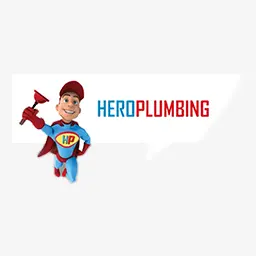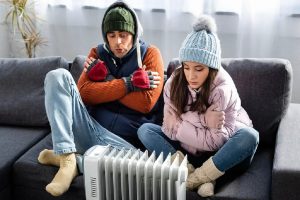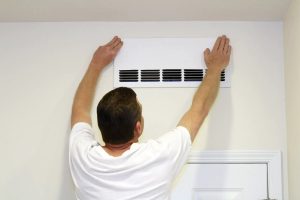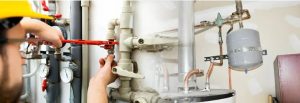Table Of Contents
- Do You Experience Frequent Headaches?
- Reasons A Gas Heater Can Cause Headaches
- Old Gas Heater
- Poor Indoor Air Quality
- Carbon Monoxide Poisoning
- Causes
- Symptoms
- Treatment
- Prevention
- Equip Your Space with Carbon Monoxide Detectors
- Service and Maintain Your HVAC System
- Always Keep Your Space Ventilated
- Ensure Your Gas Appliances Are Well Vented
- Replace Old or Faulty Gas Heaters
- Replace Your Unflued Gas Heater
- Ensure Your Chimney and Flues Are Not Clogged
- Use Your Gas Appliances as Specified
- Get A Gas Fitter To Check Your Gas Heater
Do You Experience Frequent Headaches?
Headaches are typically unpleasant, and often at times, they can be hindrances too. This is especially true if you are at work. As such, you may have noticed that you experience frequent headaches during the cold season when your gas heater is in use. If so, has that left you wondering if the gas heater in your Sydney home or office is responsible?
If your response is yes and you have indoor gas heating system, you may just want to start looking towards them as the culprit. Keep reading to learn some of the reasons why your gas heater might be causing those headaches and ways to prevent such occurrences.
Reasons A Gas Heater Can Cause Headaches

Old Gas Heater
It is known that gas heaters burn gas to produce heat. When this happens, air pollutants and water vapour are the by-products. An open flued gas heater will let the air pollutants out from the building through a flue or chimney while unflued gas heaters release them straight into your home or space.
This then means that an unflued gas heater can potentially cause air pollution in your home and pose a risk to your health. The use of an unflued gas heater can expose you to numerous air pollutants, mostly carbon monoxide (CO) and nitrogen dioxide (N02). In addition, an old unflued gas heater might be unable to meet the standards for the emission of combustion products.
If your unflued gas heater is ten years old and above, you should consider replacing it with a flued gas heater or a new unflued gas furnace. Bear in mind that installing unflued gas heaters is not allowed in some states in Australia. Therefore, ensure that you check in with a registered gas fitter before proceeding to purchase or install one.
Poor Indoor Air Quality
Your indoor air quality is another reason why a gas heater can cause headaches. That is because the air inside your space is drawn into your gas heater and distributed back into the room. Your HVAC system regulates the quality of your indoor air, and if outdoor air that is polluted finds its way into your home, it will get cycled by the HVAC system and make the indoor air unsafe to breathe in.
If your indoor air is dry, it will draw moisture from the body, leave you dehydrated, and can potentially lead to a dehydration-induced headache. In addition, dry air can leak into your home through the cracks of the doors and windows, altering indoor air quality. Equally, a leaky air duct can make your indoor air dry out more. Vapour sprays, cigarettes, and several tobacco products can also alter indoor air quality.
Carbon Monoxide Poisoning
Medical research suggests that carbon monoxide is the main culprit of gas heater-induced headaches. Carbon monoxide is a toxic gas that is odourless, tasteless, and colourless. It is the combustion product of fossil fuels like propane, gasoline, natural gas, coal, and other substances containing carbons. Carbon monoxide is termed a silent killer because it is not easily detected.
Causes
CO poisoning occurs due to exposure to high levels of carbon monoxide and, this exposure occurs mainly in the cold weather due to the frequent use of gas heaters. Using gas heaters without venting or not well vented, have faulty exhaust fans, clogged chimneys, or flues can get you exposed to carbon monoxide poisoning.
Inhaling so much of this toxic fume forces your body to replace the oxygen in your red blood cells with carbon monoxide, and poisoning occurs when there is a high level of carbon monoxide in your bloodstream.
Symptoms

Headaches or migraines are one of the common symptoms of carbon monoxide poisoning, and it generally plays a role in the early detection of CO poisoning in your space. Aside from headaches, there are numerous symptoms of carbon monoxide poisoning; they include:
- Dizziness
- Nausea and vomiting
- Suffocation or shortness of breath
- Disorientation and confusion
- Blurred vision
- Abdominal pain
In severe conditions, carbon monoxide poisoning can cause depression, hallucination, and brain damage. It can also affect mental health and cause loss of memory. Extreme exposure can lead to loss of consciousness, coma, and even death. Furthermore, when not detected early, carbon monoxide poisoning can cause complications.
Such complications include permanent brain damage (due to prolonged lack of oxygen), lifelong heart damage, and even miscarriages in pregnant women. New-born babies, persons advanced in age, pregnant women, people that suffer from chronic cardiac and respiratory diseases are at high risk of developing complications from carbon monoxide poisoning.
Treatment
In the event that you or anyone around you is experiencing symptoms of carbon monoxide poisoning, take the following steps:
Step One: Get Some Fresh Air
Leaving the environment with the poisoning will help minimise the effect of the fumes. Carry the person out of the house or go to a place where you can breathe in some fresh air. Avoid being in an enclosed or stuffy place; rather, go to an open area.
Step Two: Contact Medical Emergency
Carbon monoxide poisoning requires immediate medical attention, which will prevent further complications. While you wait for the medical team to arrive, see if you can safely switch off the source of the carbon monoxide poisoning.
Step Three: Perform CPR
In the case of loss of consciousness, perform CPR on the person while waiting for the emergency department to arrive. Perform the CPR continuously till the person starts breathing. Here are the steps for performing a CPR:
1. Inspect the scene – Once on scene, inspect for hazards and if possible use PPEs (Personal Protection Equipment).
2. Use the Shout-Tap-Shout method – If the individual seems unconscious, ensure to inspect for breathing and responsiveness as well as life-threatening injuries utilising the Shout-Tap-Shout method. This means you have opened up the individual’s airway and have checked for breathing and a pulse simultaneously.
3. If unresponsive, call an ambulance – If the individual is still not breathing or is only gasping for breath, call an ambulance or notify someone else to do it immediately.
4. Position the individual – Place the individual with their back to the floor or a firm, flat surface.
5. Start compressions – Begin by giving 30 chest compressions. To do so, start by:
- Placing both of your hands centred on the chest of the individual.
- Your shoulders should be directly over your hands, with your elbows locked firmly.
- Administer compressions at a rate of 100-120 compressions per minute.
- Remember to allow the person’s chest to return to its regular position after each individual compression.
6. Give two life breaths
- Ensure the person’s airway is in a post-neutral position using the head/chin-lift technique.
- Make sure each breath lasts around one second with the chest rising and falling (as the air exits) before giving the next breath.
NOTE: If the individual’s chest fails to rise, re-tilt their head and ensure a proper seal before administering the next breath.
7. Continue chest compressions until help arrives – Keep giving chest compressions in sets of 30 with two life breaths in between until paramedics arrive, or if the person has no pulse, an AED (Automated External Defibrillator) is handy.
NOTE: If the individual is an infant, special CPR administration is required.
Step Four: Diagnosis
A blood test is the best way of diagnosing carbon monoxide poisoning. Have a health professional diagnose you or the victim to be certain it’s carbon monoxide poisoning before proceeding with the treatment.
Step Five: Hospitalisation
The treatment for CO poisoning is a high dose of oxygen administered either from a facemask with an oxygen reserve bag attached to it or an oxygen capsule. You or the victim will be required to spend a couple of days in the hospital, especially if the poisoning is severe. The patient is allowed to go home when the level of carbon monoxide present in the blood goes down significantly.
It is advisable to have an HVAC technician conduct a home inspection and make sure your gas appliances, chimney, and flues are cleaned out and in good working condition before the patient can return home. Doing this will prevent further complications.
Step Six: Post Patient Care
It is vital to care for yourself or the patient after treatment at the hospital.
- Ensure to go back to the hospital weeks after treatment to ensure there are no underlying health complications.
- Adopting healthy living or a healthy lifestyle will go a long way to boost your health and facilitate better recovery.
- Aged patients with underlying health issues might require extra medical care and attention.
- Before you pay your next visit to a doctor, prepare your questions.
- Accompany patients advanced in age to the next doctor follow-up visit.
- Take note of all the health information provided to you by your doctor during a visit.
- If you are placed on medication by a medical professional, pay attention to how your body reacts to it and inform your doctor about any abnormal side effects.
- Monitor your progress and keep your doctor updated.
- Before you resume any treatment, find out if there is an alternative way to get treated.
Prevention

By now, it is clear to you that exposure to carbon monoxide can lead to gas heat-induced headaches. Now, let us look at measures that can help curb the future occurrence of that.
Equip Your Space with Carbon Monoxide Detectors
Carbon monoxide detectors will trigger the CO alarm to go off when there is a high level of carbon monoxide in the air. If you don’t have CO detectors in your house, have them installed and ensure that they are close to areas that have gas appliances. Always go for carbon monoxide alarms that are audible enough to be heard from your sleeping areas and with visual indications.
If you already have a CO detector, ensure that it is in good working condition and replace it if it’s not.
Service and Maintain Your HVAC System
Have your heating appliances like gas heaters and the fireplace checked and serviced before using them in the cold weather. Have a professional technician conduct testing for carbon monoxide leakage and certify them safe.
Always Keep Your Space Ventilated
Allowing fresh air into your space will reduce the concentration of carbon monoxide in your home. Ventilation is helpful especially, where unflued gas heaters are in use. In addition, ensuring that your air vents are not blocked or dirty will help cut down air pollutants.
Ensure Your Gas Appliances Are Well Vented
Keeping your gas heating appliances vented will ensure proper circulation and prevent the build-up of carbon monoxide and other toxic fumes. Don’t forget about your gas stoves, gas or wood fireplace, water heaters, charcoal grills, and other forms of space heaters.
Replace Old or Faulty Gas Heaters
Unfortunately, gas heaters can become faulty over time, and many such faults can not be repaired. As a result, it is safer to replace the whole unit. Also, an old gas heater has a high chance of posing a health and safety risk to the user. Replacing a faulty or old gas unit with a new one lowers the chances of gas leaking into your space and polluting indoor air.
Replace Your Unflued Gas Heater
As earlier stated, an unflued gas heater can cause exposure to carbon monoxide due to the way it functions. Therefore, replacing it with either an open flued gas heater or an electric heater is safer. Unlike gas heaters, electric heaters do not produce air pollutants, so installing one will potentially prevent exposure to carbon monoxide.
However, if you must use a gas heater, go for one with electric ignition and a safety alert that makes them turn off when there are air pollutants. In the meantime, avoid leaving your unflued gas heater on for a long time especially, at night.
Ensure Your Chimney and Flues Are Not Clogged
A chimney or flue that is clogged or blocked will lead to carbon monoxide leaking back into your home and contaminating the air. Therefore, always ensure your chimney or flue is clean and free of dirt. To achieve this, get a registered technician to look at and clean your chimney or flue.
In addition, ensure your exhaust fans are clean and in good working condition. However, avoid using the exhaust fans if you are using an unflued gas heater. Remember to keep your fireplace clean if you have any.
Use Your Gas Appliances as Specified
Study the user’s guide or instruction manual of your gas appliances and ensure you are using them as recommended by the manufacturers. Make sure to check for any warnings and avoid going against them. If it has a safety device, ensure to understand how to operate it. In addition, avoid using appliances like charcoal grills, lanterns, and camping stoves meant for outdoor use indoors.
Get A Gas Fitter To Check Your Gas Heater
Headaches can be a symptom of carbon monoxide poisoning caused by gas heaters, so gas heating can potentially cause headaches or migraines. Do not take any case of CO poisoning for granted because it is life-threatening. Getting your gas appliances serviced and well maintained will help reduce future occurrences.
Considering the above information, it is an excellent idea to get an expert gas fitter to examine your gas appliances and ensure they are not a source of air pollutants. Many are trusted and available 24/7, even after hours, to cater to your emergency needs. Get a free quote and have them come over to handle the situation professionally.










